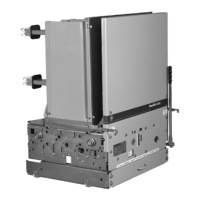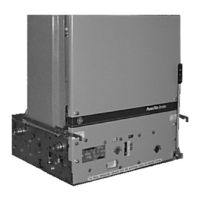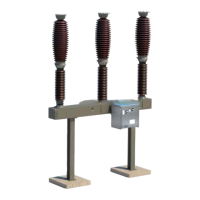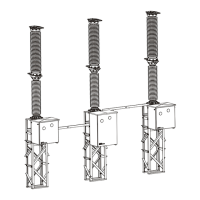5
SECTION 2—Description
2.1—General
This section contains a description of the PowerVac
®
vacuum
circuit breaker. It also describes the functions of the electrical
and mechanical systems.
2.2—Summary Description
The PowerVac
®
vacuum circuit breaker uses sealed vacuum
power interrupters to establish and interrupt a primary circuit.
Primary connections to the associated metalclad switchgear are
made by horizontal bars and disconnect fingers, electrically and
mechanically connected to the vacuum interrupters. Molded
interrupter supports, one per phase on a three-phase circuit
breaker, provide mountings for the primary bars, interrupters,
current transfer fingers, and heat dissipation fins (where used).
The operating mechanism provides direct motion at each phase
location in order to move the movable contact of the vacuum
interrupters from an open position to a spring-loaded closed
position and then back to the open position on command.
The ML-20 mechanism is of the stored-energy type and use a
gear motor to charge a closing spring. During a closing operation,
the energy stored in the closing spring is used to close the
vacuum interrupter contacts, compress the wipe springs which
load the contacts, charge the opening springs, and overcome
bearing and other friction forces, The energy then stored in the
wipe springs and opening springs will open the contacts during an
opening operation.
Closing and opening operations are controlled electrically by the
metalclad switchgear or remote relaying. Mechanical control is
provided by manual close and trip buttons on the circuit breaker.
The closing spring may be manually charged, and a method for
slow-closing the primary contacts is available. The mechanism will
operate at the ac or dc voltage indicated on the circuit breaker
nameplate.
Mechanical and electrical interlocks are provided and are
described in para 4.2, Interlocks
SECTION 3—Receiving, Handling and Storage
3.1—Receiving
A. Equipment Packages
Every package leaving the factory is plainly marked with the case
number, requisition number, and customer’s order number. If the
equipment has been split for shipment, the section numbers of
the equipment enclosed in each shipping package are identified.
NOTE: To avoid loss of any parts when unpacking, the contents
of each container should be carefully checked against the packing
list before discarding the packing material.
Contents of each shipping package are listed on the Master
Packing List. In addition, this list includes the number of the
shipping crate in which miscellaneous parts needed to install and
operate equipment (such as hardware, contact lubricant, touch-up
paint, breaker closing devices, etc.) are located. Normally, such
devices are packed in a cardboard carton.
B. Inspecting for Damage
All equipment leaving the factory is carefully inspected and
packed by personnel experienced in the proper handling and
packing of electrical equipment. Upon receipt of any equipment,
immediately perform a visual inspection to ascertain if any
damage has been sustained in shipping or if there are any loose
parts.
C. Filing a Claim
If any damage is evident, or indication of rough handling is
visible, file a claim for damage at once with the transportation
company and notify the nearest GE Company Sales Office
immediately. Information on damaged parts,
part number, case
number, requisition number, etc., should accompany the claim.
3.2—Handling
When lifting the breaker, use of the specially designed lift truck is
recommended. If it is necessary to lift the breaker with a hoist use
four 1/2 inch diameter hooks rated at least 500 pounds each.
Lifting holes are provided in the four corners of the frame
members. (See figure 2) Use a spreader wider than the breaker
to prevent slings from contacting the interrupter supports.
3.3—Storage
It is recommended that the breaker be put immediately in its
permanent location. If this is not possible, the following
precautions must be taken to assure proper breaker storage.
1. The breaker should be protected against condensation,
preferably by storing it in a warm dry room of moderate
temperature such as 40° - 100°F. Circuit breakers for outdoor
metalclad switchgear should be stored in the equipment only
when power is available and the heaters are in operation to
prevent condensation.
2. The breaker should be stored in a clean location, free from
corrosive gases or fumes; particular care, for example,
should be taken to protect the equipment from moisture and
cement dust, as this combination is present at construction
sites and has a very corrosive effect on many parts.
3. Rollers, latches, etc., of the operating mechanism should
be coated with 0282A2048P009 grease to prevent
rusting.
If the breaker is stored for any length of time, it should be
inspected periodically to see that rusting has not started and
to ensure good mechanical condition. Should the breaker be
stored under unfavorable atmospheric conditions, it should be
cleaned and dried out before being placed in service.
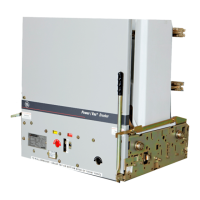
